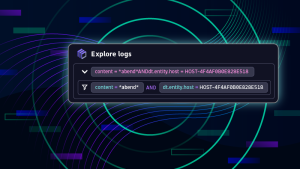Infrastructure as code automates the manual processes of application management and provisioning. Discover everything from the basics to best practices and how Dynatrace can make it easy.
The IT industry is rife with jargon — and “as code” is no exception. “As code” means simplifying complex and time-consuming tasks by automating some, or all, of their processes. Today, the composable nature of code enables skilled IT teams to create and customize automated solutions that can improve efficiency on a massive scale. Thanks to the advent of user-friendly coding languages and various powerful automation platforms, almost anything can be “as code.”
While this methodology extends to every layer of the IT stack, infrastructure as code (IAC) is the most prominent example. Here, we’ll explore the basics, benefits, and best practices of IAC, as well as how to choose infrastructure-as-code tools that help make it easy.
What is infrastructure as code?
Infrastructure as code is a practice that automates IT infrastructure provisioning and management by codifying it as software. This approach empowers developers to define and automatically deploy the necessary infrastructure components to support applications as they build them, increasing agility. IAC uses descriptive code that, in many ways, mimics the DevOps approach to source code. In turn, IAC offers increased deployment speed and cross-team collaboration without increased complexity.
But this increased speed can’t come at the expense of control, compliance, and security. That’s why developers need to work closely with centralized operations teams to ensure they incorporate observability throughout development.
What challenges does IAC solve?
IAC solves the issue of complex infrastructure environments. In large organizations, it’s not uncommon to have hundreds of applications — each with its own specific infrastructure requirements based on architecture, function, traffic, and more. Increasing numbers of unique environments also mean more complexity in new deployments, as changes on one stack may not produce the same effect in others.
As a result, IT teams often end up performing time-consuming, manual processes. This scenario also makes it difficult for operations teams. Because they are often centralized and removed from the development process, it’s harder for operations teams to effectively observe and manage their environment. This can cause performance and security issues — in turn, costing organizations time and money. With IAC, however, IT teams can automate those tasks and focus on more business-critical issues.
Breaking down the benefits of infrastructure as code
Making the move to IAC offers multiple benefits, including the following:
- Speed. By automating infrastructure deployment and configuration, organizations can streamline their software development lifecycle, delivering higher-quality software faster while improving cross-team collaboration.
- Consistency. Code-based infrastructure enables developers to provision applications based on best practices, limiting the potential for human error and freeing system administrators for more important tasks.
- Alignment. IAC improves cross-team collaboration and alignment, as the developers who know the applications and their infrastructure requirements best can define these requirements as they build.
How does IAC work?
IAC automates infrastructure configuration and tasks, such as resource management and monitoring, to streamline IT operations, create consistency, and provide visibility.
In practice, IAC creates scripts that define desired end states either by laying out a series of steps to achieve the preferred end goal or outlining the desired end state. In both cases, the goal is to create repeatable and identical infrastructure environments to minimize overall complexity.
Weighing the different approaches to infrastructure as code
There are two broad approaches to IAC: imperative and declarative. While imperative IAC provides step-by-step directions, declarative IAC offers a template for the final outcome.
Imperative IAC specifies the commands that define infrastructure configurations. This approach to IAC uses object-oriented programming languages, such as Java or C++.
Declarative IAC, meanwhile, outlines the end state of infrastructure, but doesn’t lay out specific steps. IT teams often use languages such as SQL or Haskell for declarative IAC.
Exploring IAC best practices
While there’s no one-size-fits-all model for how to deploy IAC, there are several best practices that can streamline how teams implement and use it.
- Test, test, test. Because IAC is code, it needs regular testing. In this respect, it’s like software development — more testing means more reliable outcomes.
- Prioritize a single source of truth. Developers should keep all infrastructure specifications and instructions in configuration files. In turn, these become a single source of truth for all IAC operations.
- Deploy version management. Over time, a source of truth will evolve. It’s important to deploy version management tools, so teams know what changed, when, and why.
- Minimize overall documentation. One of IAC’s biggest benefits is reduced complexity through automation. Over-documentation reintroduces this issue and can lead to environments and configuration data being out of sync. Because configuration files form a single source of truth, they require minimal documentation.
- Address monitoring at scale. While efficient, IAC creates a layer of abstraction that can result in teams losing visibility and control. To maintain visibility into how infrastructure affects application availability, performance, and security, it’s critical for developers to incorporate observability throughout the development lifecycle. To do so, developers can use monitoring as code to define, deploy, and instrument observability as they build.
Choosing the right infrastructure-as-code tools for your needs
Infrastructure-as-code tools are designed to further simplify the process of configuring and modifying infrastructure. They use one of two methods to accomplish a goal: push or pull.
In a push framework, a centralized server sends configuration data to specific systems. In a pull framework, the systems themselves initiate configuration data requests. Most tools default to one method, but organizations can change that as required.
Some popular tools on the market include Chef, Ansible, Terraform, and Puppet. However, the best fit for your IAC deployment depends on your current needs and long-term goals.
Infrastructure as code made easy with automatic and intelligent observability
Infrastructure as code can speed deployments, reduce costs, improve consistency, and empower alignment with DevOps initiatives. But the move to IAC doesn’t happen in isolation. As part of larger IT environments, as-code solutions require increased observability and monitoring to deliver a high return on investment. While infrastructure-as-code tools make it possible to quickly spin up identical infrastructure environments that streamline provisioning and maintenance, even minor issues can become big problems if they replicate at scale.
By deploying robust and responsive monitoring-as-code solutions, organizations can proactively identify and remediate potential issues before teams deploy infrastructure, saving time and money. That’s where Dynatrace can help. By combining Dynatrace’s PurePath 4 intelligent tracing technology with the Monaco monitoring-as-code solution, organizations can shift IAC management left for enhanced control and improved outcomes.
IAC is just the beginning. Enhance IT environments embracing as-code at scale. To get started, check out Dynatrace performance clinics on monitoring as code and SLOs as code for more information.





Looking for answers?
Start a new discussion or ask for help in our Q&A forum.
Go to forum